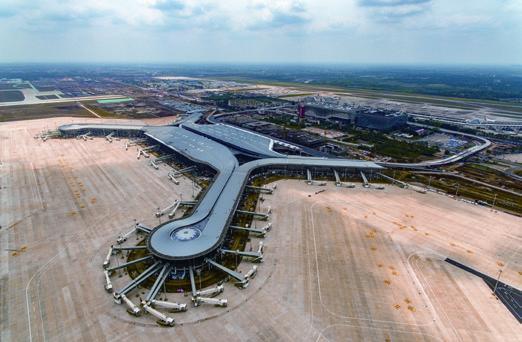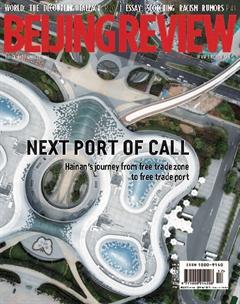READY FOR BIGGER THINGS
By Li Nan


Log in. Declare online. Wait for an hour. Approved! Liu Xinyuan, Manager of Hainan Rouming Red Heart Dragon Fruit Co., heaved a sigh of relief when he saw the approval for his application to export dragon fruit flashing on the online government service platform of Hainan, the southernmost Chinese province where his company is based.
Spring is the harvest season for tropical fruits and Liu planned to export dragon fruit to Europe in early February. But with the novel coronavirus epidemic forcing many offices to stay closed, Liu had worried that customs clearance would take a long time and the fruits might go bad.
To his surprise, he got a phone call from a local customs officer who asked him to declare his goods online on the platform the local government had launched in April 2019, one year after the province was approved to be a pilot free trade zone (FTZ). The platform provides one-stop services for enterprises, where they can complete more than 20 business procedures online, such as registering businesses, applying for projects and opening bank accounts.
Liu submitted his application with alacrity and the approval came in at a click. Efficient, paperless and contact free, online approval is an important measure to mitigate the impact of the epidemic. The one-stop online service window has slashed clearance time for various procedures from two days to two hours on average.
Besides online clearance, Hainan customs employs state-of-the-art equipment, like the H986 X-Ray machine that can scan large containers without opening them. “In the past, we had to open the containers to examine the goods manually. With the new machine, inspection speed has been accelerated by 70 percent,” Yu Ke, a customs officer, told Legal Times.
The improved efficiency mirrors the growth of the Hainan FTZ in the two years since President Xi Jinping announced on April 13, 2018 that Hainan would become the countrys newest FTZ with the prospect of developing into the first free trade port (FTP) on the Chinese mainland. This year, the local government celebrated the day by launching 100 projects and inking 100 new contracts with investors in Haikou, the provincial capital. In the past two years, 893 projects have been launched in Hainan with total investment of 484.1 billion yuan ($68 billion).
“Remarkable results have been made in building the Hainan Pilot FTZ, laying a good foundation for the FTP,” Tang Wenhong, Director General of the FTZ and FTP Department of the Ministry of Commerce (MOFCOM), said that day, referring to the fact that 97 percent of the goals set in the general action plan released by the State Council soon after Xis announcement have been accomplished.
“MOFCOM data shows the construction of the Hainan Pilot FTZ is on the fast track,” Sang Baichuan, Dean of the Institute of International Economy at the University of International Business and Economics (UIBE) in Beijing, told Beijing Review. He said Hainans business environment has been improved and preliminary breakthroughs have been made in opening up, making the island more popular with investors, business operators and talents.
Growth curve
In 2019, the island established service trade partnerships with 123 countries and regions around the world. Last year, 220,000 new companies were set up in Hainan, up 71 percent year on year. Paid-in foreign investment growth doubled that in the previous year and Hainan notched up a service trade surplus of 653 million yuan ($92.3 million). Well-known service enterprises from home and abroad are settling down on the island.

The four leading accounting firms in the world, PricewaterhouseCoopers, Ernst & Young, KPMG and Deloitte, have opened their offices in Haikou. iFlytek, a Chinese artificial intelligence service giant, has established a branch in the city of Sanya, offering services in smart city development, education and interpretation and translation.
Hainan is courting investors in insurance, construction, maritime transport, new-energy vehicles and other emerging industries with incentive measures. Foreign investors are treated on par with domestic investors in the preestablishment period and are given access to industries except those on the negative list.
Medical haven
On April 10, a special international exhibition showcasing more than 300 kinds of medical devices that were yet to hit store shelves in China opened in the Lecheng International Medical Tourism Pilot Zone, an initiative of the local government to build a world-class medical and wellness destination. The pioneering exhibition offers a channel for foreign medical device makers to enter the Chinese market. Thirty international medical equipment providers took part in it with products such as advanced artificial lungs and ear implants.
Massachusetts-based Boston Scientific showcased 24 items, including a disposable duodenoscope, a lighted tube used to inspect the small intestine. The new device was released in the U.S. late last year. “It appears on the Chinese market less than 100 days after its debut in the U.S. Its unimaginable in the past!” said Yan Xiaoliang, the companys marketing director for its digestive endoscopy department in China.
Established in 2013, the medical tourism pilot zone lies close to the permanent venue of the Boao Forum for Asia Annual Conference. It offers healthcare services including rehabilitation and cosmetic surgery and is the only medical pilot in China where medical equipment and drug imports enjoy lower tariffs, foreign doctors are given extended employment contracts and foreign-funded hospitals are allowed.
Last year, Hainan rolled out policies to open the island up wider to the international medical market. They include accepting survey and clinical trial data to assess the efficacy of new medicines and medical equipment to be imported into the province. Thanks to the policy, a long-term eye implant for glaucoma, produced by American biopharmaceutical company Allergan, was approved for the pilot zone on March 26. It was the first medical product to enter the Chinese market based on real-world clinical data. The company has submitted application for introducing another product in the same way.
“About 600,000 Chinese go abroad to seek medical treatment every year, to access better medical solutions,” Shen Xiaoming, Governor of Hainan, said at a press conference in September 2019. With this policy, he hoped such medicines and treatment would be available at home.
By the end of last year, 51 medical devices had been approved for trial use in Lecheng, which benefited nearly 300 patients. The medical pilot zone received 75,000 medical tourists, generating revenue of 640 million yuan ($90.5 million).

Hainan is also opening it door wider to foreign visitors. People visiting from 59 countries for a wide range of purposes can avail of a 30-day visa-free policy since May 1, 2018. More than 771,800 overseas visitors had entered Hainan visa-free as of April 8.
The island is also more connected to the rest of the world. As of 2019, it was linked to 62 overseas cities via 103 international air routes. In 2019, the number of inbound tourists reached 1.44 million, up 14 percent year on year.
From FTZ to FTP
The year 2020 is the first one to start building the Hainan Pilot FTP, according to a briefing by the Hainan Provincial Government in December. However, there are some challenges.
The impact of the novel coronavirus pandemic is the most immediate challenge. Xia Feng, a research fellow with the School of Politics and Public Administration of Hainan University, told Beijing Review that in the short term, social distancing enforced to contain the outbreak would impact Hainans pillar industries, including tourism, medical care and exhibition. In the medium and long term, it would affect the global supply and industrial chains.
Internally, compared with other pilot FTZs and Hong Kong, the only full-fledged FTP in China, Hainans economy is weak, Xia added. And finally, with the rise of trade protectionism and anti-globalization, some countries are considering localizing their supply and industrial chains. “This will undoubtedly have a negative impact on Hainans opening up,” he said.
Xia said that the Hainan Pilot FTP needs institutional innovation, high-level opening up and effective risk prevention and control. Hainan should speed up opening its service market, shorten its negative list for foreign investment, and reduce trade barriers in the service sector to transform into an innovation-driven FTP with flourishing service trade.
UIBEs Sang said Hainan should improve its trade and investment liberalization and facilitation, and reduce tariff to zero in the goods trade. The financial system should be reformed to promote cross-border capital flow and settlement. Last but not the least, it should work to attract more talented people and facilitate the smooth flow of personnel.

